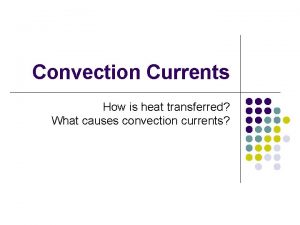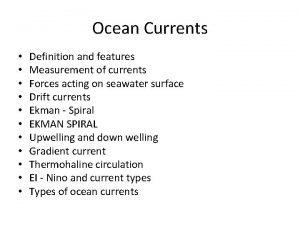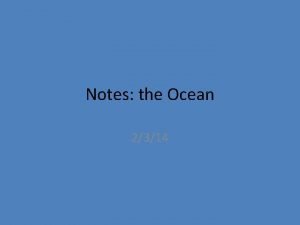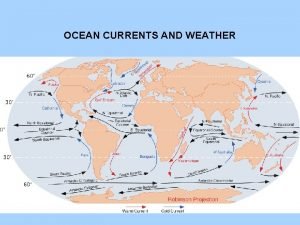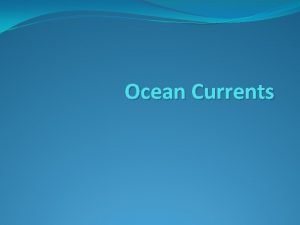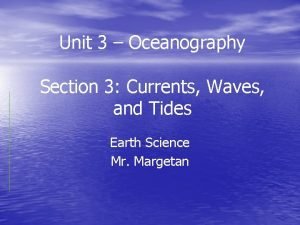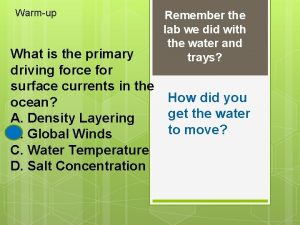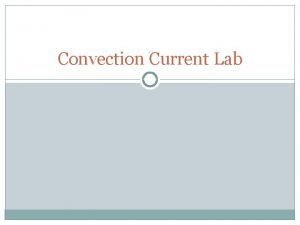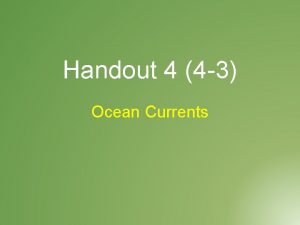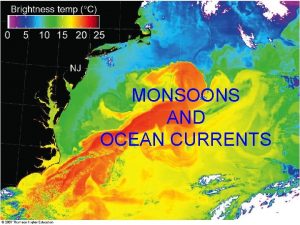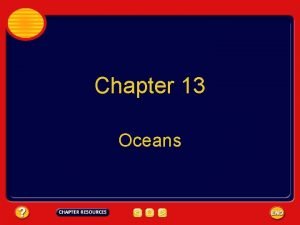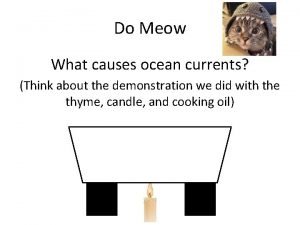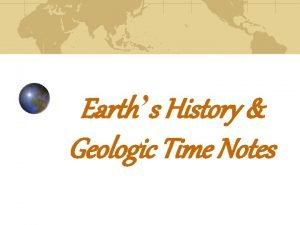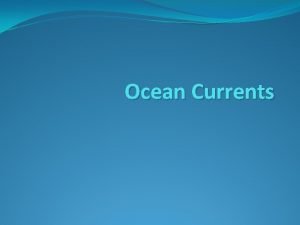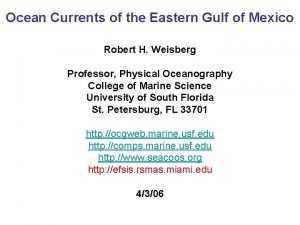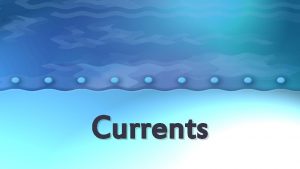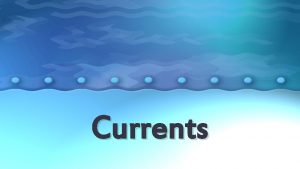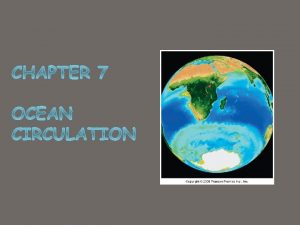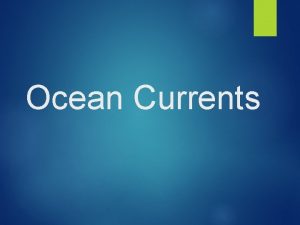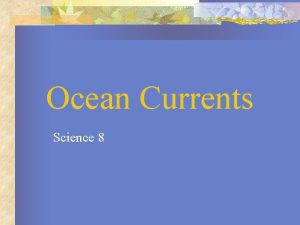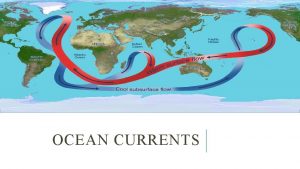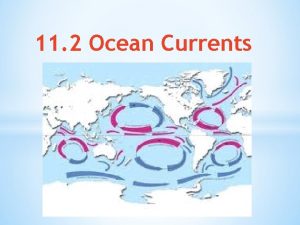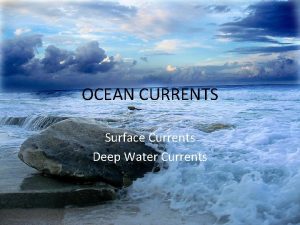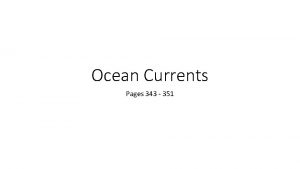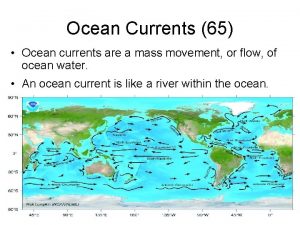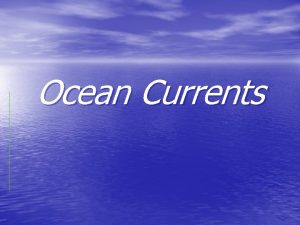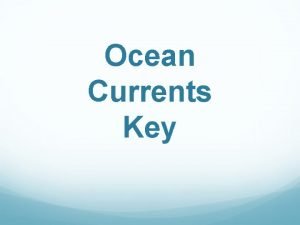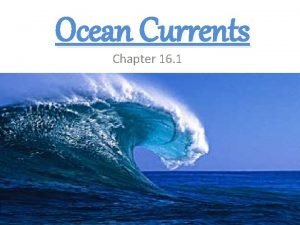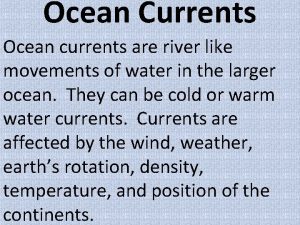Ocean Currents Climate Currents Large streams of moving




















- Slides: 20

Ocean Currents & Climate

Currents Large streams of moving water that flow through the oceans • surface current – wind-driven currents which affect water to a depth of several hundred meters and can move as fast as 100 km/day

How do winds impact surface currents? • Cause surface currents to flow in the direction that the wind is blowing. • Example: Jet Stream

Gyres Earth’s oceans contain large, looped systems of surface currents called gyres. Gyres in the northern hemisphere circle clockwise. Gyres in the southern hemisphere circle counterclockwise this is known as the Coriolis effect.

Coriolis Effect Movement of wind and water to the right or left that is caused by Earth’s rotation

Deep currents Caused by differences in density of ocean water Deep currents - move and mix water around the Earth, moving slower than surface currents, carrying cold water from poles to equator Upwellings – movement of cold water to the surface to replace warmer water and bring tiny organisms, minerals and other nutrients from deep ocean layers keeping the ocean ecosystem in balance.

What causes deep ocean currents? • The vertical movement of ocean currents that mixes with deep waters. Caused by: • Change in density: Denser water SINKS – Change in temperature: Decreasing temperature increases density – Change in salinity: Increasing salinity increases density

Climate Pattern of temperature and precipitation typical of an area over a long period of time • Solar energy drives convection currents in the ocean. Surface currents warm or cool the air above it, influencing the climate of the land near the coast.

Great Ocean Conveyor Belt Another large system of ocean currents that affect weather and climate. It is a global “belt” of surface and density currents that distribute thermal energy around Earth. Cold water currents: Bring cold water the surface to warmer regions (upwelling) Warm water currents: Bring warm water to colder regions

How do currents affect climate? • Water holds heat very well (high heat of vaporization!), so ocean currents easily transfer heat across the Earth • When currents from the equator (low latitude) move towards the poles (high latitude), heat is transferred from warmer to cooler areas • As cold water currents travel toward the equator, they help regulate the warm temperatures of nearby land areas.


How do currents affect coastal climates? • Ocean currents are important to coastal regions because they can warm or cool air temperatures along the coast. Think about how it tends to be warm/cold during the winter/summer on the coast • Interesting side note – the Atacama desert! One of the driest places on earth is partially caused by a coastal current

Atacama Desert The Atacama Desert is one of the driest places on Earth. The Atacama is in the country of Chile in South America. In an average year, much of this desert gets less than 1 millimeter (0. 04 inch) of rain! That makes it 50 times drier than Death Valley in California. The Atacama is the driest hot desert in the world. There are some weather stations in the Atacama where there has never been any rain! Not all deserts are hot. The Dry Valleys in Antarctica are cold deserts. They are the driest deserts on Earth. The Atacama is also one of the oldest deserts in the world. Scientists think parts of it have been dry for at least 20 million years and maybe as long as 40 million years. That is much older than other very deserts. The Dry Valleys of Antarctica are about 10 -11 million years old. The Namib Desert in Africa is only 5 million years old. Some dry river beds in the Atacama haven't had water flowing in them for 120, 000 years!

Why so dry? Winds and Currents! • First there are two air currents that bring dry air into the regio, second it is located in a “rain shadow” between two mountain ranges (the Andes and the Chilean Coastal Range) and lastly the cold ocean current call the Humboldt current carries water up from Antarctica. The cold current of water cools the air as it is coming in from the ocean stripping it of moisture because cooler air can not keep as much moisture as warm air.

How do ocean currents affect climate? • Ocean circulation can result in climate changes. • El Niño: periodic warming of the ocean that occurs in the central and eastern Pacific • Tends to happen April-October

What causes El Nino? • Trade winds normally blow west towards the Pacific and push warm surface water away from the coast of South America and towards Australia/Asia • This water is cold and rich in nutrients. • During El Nino, trade winds calm down in the central and western Pacific, causing warm water to gather near the surface.

http: //usatoday 30. usatoday. com/weather/ resources/graphics/2008 -09 -25 -el-nino-la -nina-affect-us-weather_n. htm

Normal conditions During El Niño


What are the effects of El Nino? • Mudslides in California from heavy rain • Droughts US Midwest, Central America, Australia • Unusually mild winters in eastern US • Dying off of fish in western Pacific because of nutrient loss. • ice storms in eastern Canada and New England
 What is a deep current
What is a deep current What causes convection current
What causes convection current Currents definition
Currents definition What are ocean currents
What are ocean currents Www.gulfstreamshutdown.com
Www.gulfstreamshutdown.com Ocean currents vocabulary
Ocean currents vocabulary Ocean currents
Ocean currents What is the primary driving force of surface ocean currents
What is the primary driving force of surface ocean currents Convection currents arrows
Convection currents arrows Longshore currents move sediment as they _____.
Longshore currents move sediment as they _____. Ocean currents
Ocean currents Ocean currents waves and tides
Ocean currents waves and tides Cold peruvian current
Cold peruvian current Rubber ducks ocean currents activity
Rubber ducks ocean currents activity Why are tropical climates so hot brainpop
Why are tropical climates so hot brainpop What are ocean currents
What are ocean currents Cenozoic mammals
Cenozoic mammals Ocean currents vocabulary
Ocean currents vocabulary Ocean currents gulf of mexico
Ocean currents gulf of mexico Ocean currents
Ocean currents Ocean currents
Ocean currents

